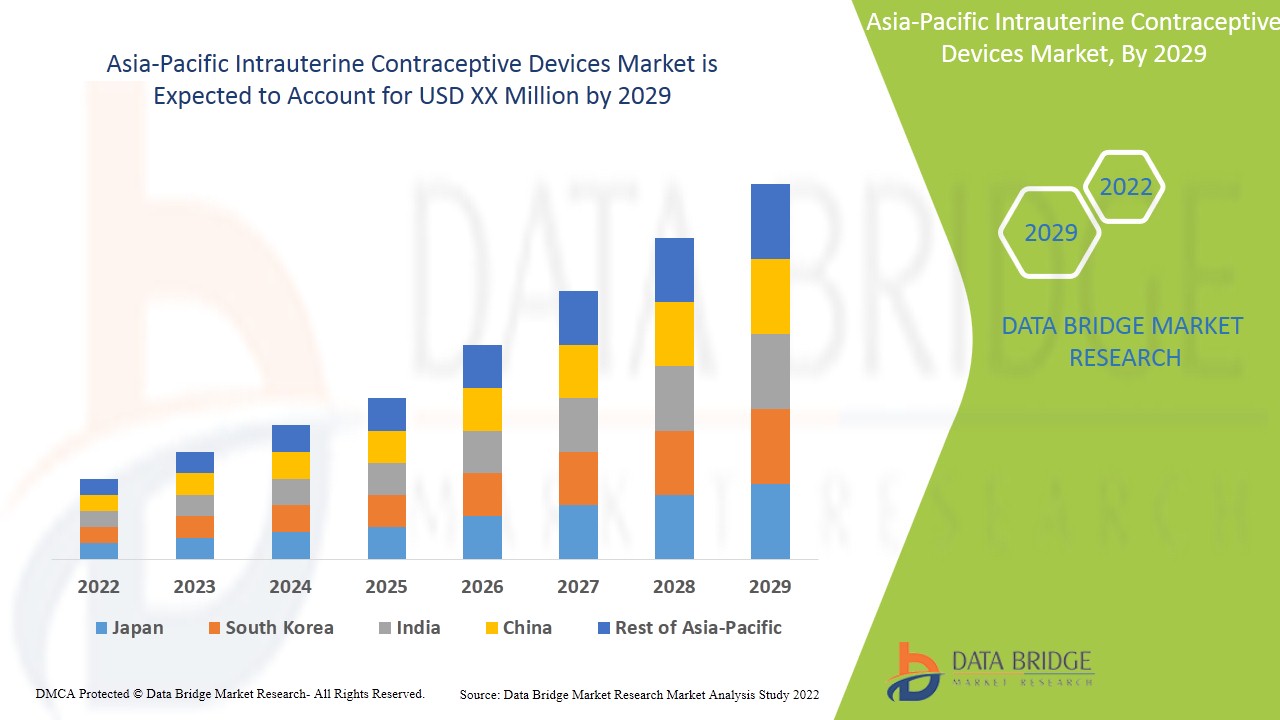Asia-Pacific Intrauterine Contraceptive Devices Market, By Type of Product (Hormonal, IUCD and Copper IUCD), End Use (Hospitals, Gynaecology Clinics, Community Healthcare and Others), Country (Japan, China, India, South Korea, Australia, Singapore, Malaysia, Thailand, Indonesia, Philippines, Rest of Asia- Pacific) Industry Trends and Forecast to 2029.
Market Analysis and Insights of Intrauterine Contraceptive Devices Market
Rising prevalence of unwanted pregnancies globally, increased focus of the manufacturers on the adoption of advanced technologies and increasing research and development proficiencies have led to the rise in intrauterine contraceptive devices market value. Data Bridge Market Research analyses that the intrauterine contraceptive devices market will exhibit a CAGR of around 10.55% for the forecast period of 2022 to 2029.
Intrauterine contraceptive device (IUD) is a T-shaped, small-sized, birth control device that is inserted into the uterus (womb) to prevent conception or pregnancy. Intrauterine contraceptive device (IUD) prevents the egg and the sperm from meeting. This is done in two ways which are either immobilizing the sperm on their way to the fallopian tubes or changing the lining of uterus so that the egg cannot fertilize.
Growing technological advancement in medical technology, rising rate of unintended and unmet contraceptive needs and lucrative opportunities offered by emerging economies such as India, South Korea, Malaysia, Vietnam, Africa, and Middle Eastern countries will propel the market growth rate. Rising public expenditure to develop healthcare infrastructure coupled with rising number of government and NGO initiatives to spread awareness about population control will further propel growth in the market value. Growing personal disposable income will also emerge as other important market growth determinants.
However, lack of the professionals and technological experts, unfavourable reimbursement scenario and budgetary constraints in the developing and underdeveloped economies will challenge the growth of market in the forecast period mentioned above. Also, restriction from religious communities, threat of ectopic pregnancy and occurrence of pelvic inflammatory diseases will obstruct the market growth rate.
This intrauterine contraceptive devices market report provides details of new recent developments, trade regulations, import export analysis, production analysis, value chain optimization, market share, impact of domestic and localised market players, analyses opportunities in terms of emerging revenue pockets, changes in market regulations, strategic market growth analysis, market size, category market growths, application niches and dominance, product approvals, product launches, geographic expansions, technological innovations in the market. To gain more info on intrauterine contraceptive devices market contact Data Bridge Market Research for an Analyst Brief, our team will help you take an informed market decision to achieve market growth.
Asia-Pacific Intrauterine Contraceptive Devices Market Scope and Market Size
The intrauterine contraceptive devices market is segmented on the basis of type of product and end-use. The growth amongst these segments will help you analyse meagre growth segments in the industries, and provide the users with valuable market overview and market insights to help them in making strategic decisions for identification of core market applications.
- Based on type of product, Asia-Pacific intrauterine contraceptive devices market is segmented into hormonal IUCD, and Copper IUCD.
- Asia-Pacific intrauterine contraceptive devices market has also been segmented based on the end use into hospitals, gynecology clinics, community healthcare, and others.
Intrauterine Contraceptive Devices Market Country Level Analysis
The intrauterine contraceptive devices market is segmented on the basis of type of product and end-use.
The countries covered in the intrauterine contraceptive devices market report are China, Japan, India, South Korea, Singapore, Malaysia, Australia, Thailand, Indonesia, Philippines, and Rest of Asia-Pacific (APAC) in the Asia-Pacific (APAC).
China dominates the Asia-Pacific intrauterine contraceptive devices market due to fast developing healthcare sector, and government promoting intrauterine contraceptives.
The country section of the intrauterine contraceptive devices market report also provides individual market impacting factors and changes in regulation in the market domestically that impacts the current and future trends of the market. Data points such as consumption volumes, production sites and volumes, import export analysis, price trend analysis, cost of raw materials, down-stream and upstream value chain analysis are some of the major pointers used to forecast the market scenario for individual countries. Also, presence and availability of global brands and their challenges faced due to large or scarce competition from local and domestic brands, impact of domestic tariffs and trade routes are considered while providing forecast analysis of the country data.
Healthcare Infrastructure Growth Installed base and New Technology Penetration
The intrauterine contraceptive devices market also provides you with detailed market analysis for every country growth in healthcare expenditure for capital equipment, installed base of different kind of products for digital health technologies market, impact of technology using life line curves and changes in healthcare regulatory scenarios and their impact on the intrauterine contraceptive devices market. The data is available for historic period 2010 to 2020.
Competitive Landscape and Intrauterine Contraceptive Devices Market Share Analysis
The intrauterine contraceptive devices market competitive landscape provides details by competitor. Details included are company overview, company financials, revenue generated, market potential, investment in research and development, new market initiatives, global presence, production sites and facilities, production capacities, company strengths and weaknesses, product launch, product width and breadth, application dominance. The above data points provided are only related to the companies’ focus related to intrauterine contraceptive devices market.
The major players operating in the intrauterine contraceptive devices market report are Melbea AG, Pregna International Limited, Meril Life Sciences Pvt. Ltd., Medu Scientific Ltd, SBM Corporation, ZheijangDaji Medical Instruments, Ltd, Teva Pharmaceuticals Industries Ltd., DKT INTERNATIONAL, Bernstein Liebhard LLP., SMB Corporation of India among others.
SKU-


